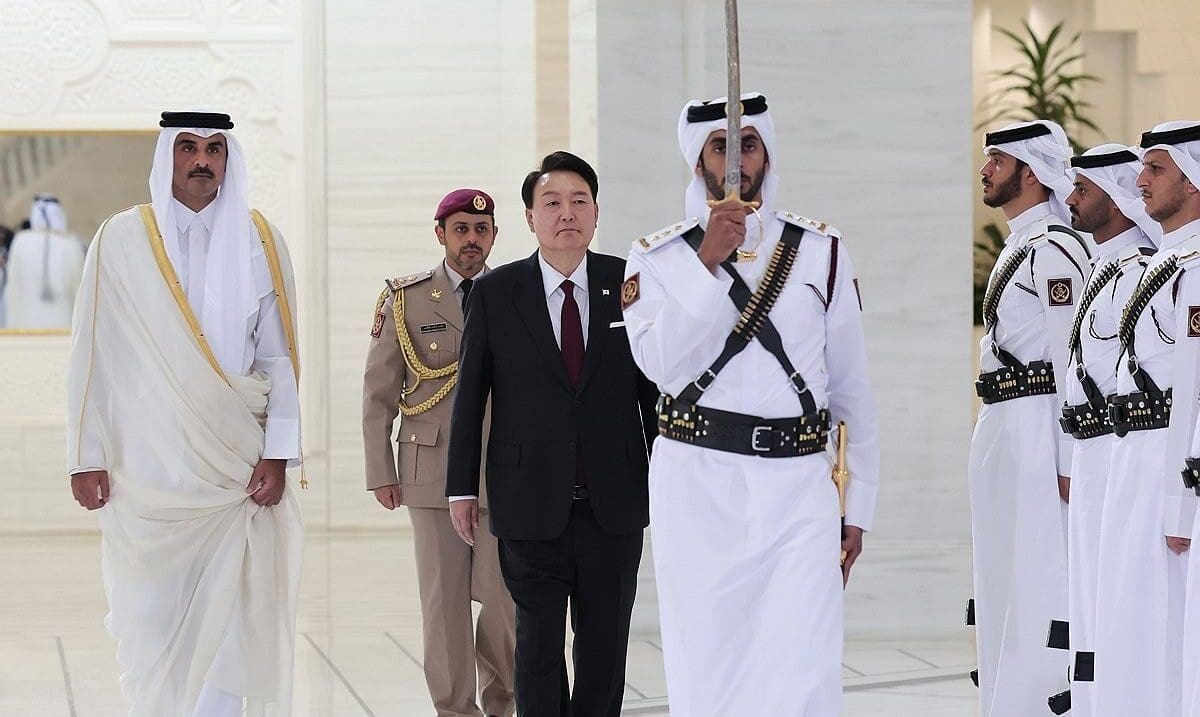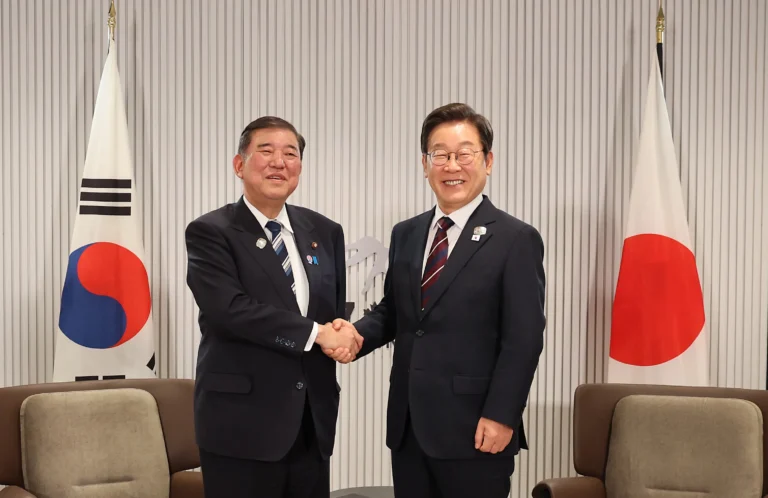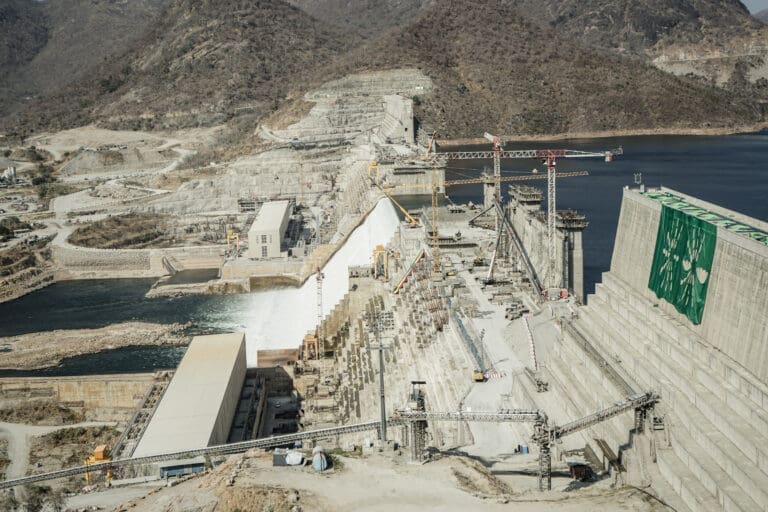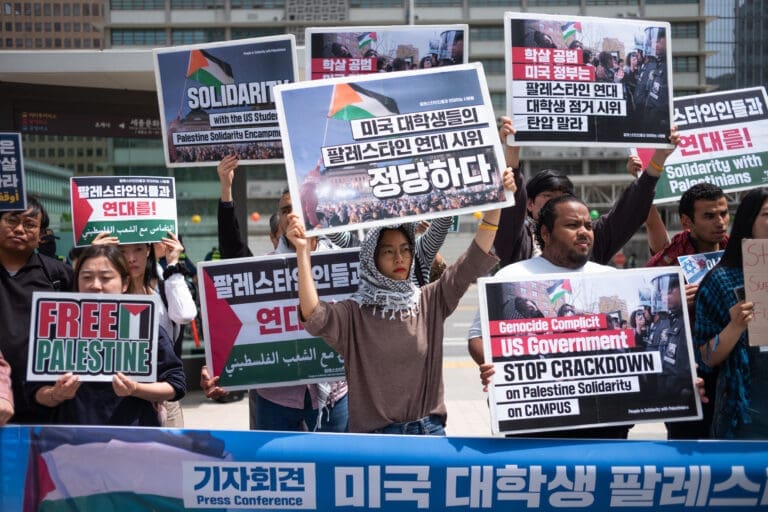
The US Energy Dominance Agenda and the Future of Qatar-South Korea Ties
Policy Note, April 2025
Introduction
The Trump administration increasingly views its foreign policy through a mercantilist lens, exerting pressure on long-term allies to buy more American products and services and invest in the United States. As part of the administration’s efforts to reduce its trade imbalances, Washington is stepping up pressure on allies and partners, such as the Republic of Korea (ROK), to purchase American liquefied natural gas (LNG) and invest in U.S. LNG projects. Currently, ROK runs the 8th largest trade deficit with the United States,1 it is therefore no surprise that the country is firmly in the new administration’s cross hairs.
Simultaneously, Seoul is seeking to diversify its energy suppliers and address its over-reliance on energy imports from the Middle East. These dynamics could herald gradual shifts in South Korea-Gulf energy relations, particularly with countries like Qatar, which has been a major exporter of LNG to Korea. This policy note argues that Qatar should increase the flexibility of its LNG contracts to manage increased competition and adapt to greater LNG capacity coming online in the near future. For its part, South Korea should view its relationship with Qatar not only through the narrow lens of LNG imports, but through a more long-term strategic vision that views the relationship holistically, in both commercial and political terms.
‘Drill, Baby, Drill’
The second Trump administration is pursuing an “Energy Dominance” agenda, largely aligned with the first administration’s policies, aimed at maximizing U.S. domestic energy production and turning the country into a leading exporter of oil and natural gas. This policy frames U.S. energy resources as strategic assets that can be leveraged to fuel economic growth at home while advancing American interests abroad.2 Promoting LNG exports, as a tool for both economic gain and geopolitical leverage, is a cornerstone of this approach.
U.S. natural gas exports have increased annually since 2014. In 2017, the U.S. became a net exporter for the first time since the late 1950s.3 In 2023, U.S. natural gas exports reached a record high, representing approximately 26% of total U.S. energy exports.4 To build on this momentum, the current administration is seeking to increase the country’s LNG production capacities by removing environmental protections and restrictions.
During his 2024 election campaign, Donald Trump pledged to cut energy prices by boosting U.S. domestic production, declaring: “We will drill, baby, drill.”5 In March 2025, during his State of the Union Address to Congress, President Trump announced plans for the development of the $44bn Alaska LNG project6which would be instrumental to the Administration’s energy ambitions. According to President Trump, both the ROK and Japan have reportedly stated their intent to invest in the project.7
The View from Seoul
The United States is a major market for South Korean exports. In 2024, the ROK’s exports to the United States were worth approximately $131.5 billion,8 ranging from vehicles and machinery to electronics and steel. Given the administration’s tariff-heavy approach, South Korea is unsurprisingly worried about the potential impact of the 25% tariff imposed by the United States.9
In March, Duk-geun Ahn, South Korea’s Minister for Trade, Industry, and Energy announced that the United Stated agreed to establish a working-level group to discuss the Alaska LNG project, as well as boosting energy imports from Washington, shipbuilding, tariffs and non-tariff barriers. Ahn added, “South Korea has a high dependence on the Middle East for energy suppliers, making diversifying import sources a key part of energy security.”10
In addition to the trade deficit that the ROK runs with the United States, the country relies on American security guarantees for its defense. The presence of more than 25,000 U.S. troops in South Korea has historically been vital to the Korean peninsula’s peace and stability.11 But over the past decade, Trump has accused the ROK of being a security “free rider.”12 From Seoul’s perspective, appeasing Washington through increased LNG imports and investments in the Alaska pipeline not only serve its energy interests, but also its defense and national security interests.
Is the Era of Long-Term Deals Over?
However, any recalibration of South Korean LNG imports may impact Seoul’s ties with Doha. As of 2023, South Korea is the second-largest importer of Qatari LNG, which accounts for 19.5% of its annual consumption.13 In 2021, KOGAS, South Korea’s state-run natural gas company, signed a 20-year deal with QatarEnergy under which the former would purchase 2 million tons of LNG annually from the latter, starting in 2025.14 Despite this deal and others, the evolving dynamics of the LNG market may complicate Qatar’s efforts to sign additional long-term deals in the future.
Firstly, South Korea will likely increase its purchases of U.S. LNG to placate the Trump administration, importing up to seven million tons of American LNG annually.15 According to Korean media, the move aims to reduce Seoul’s LNG imports from Qatar, given the looming expiration of existing long-term contracts and efforts to diversify energy sources. In addition to potential investments in the Alaska pipeline, Korea and the United States are planning to jointly construct a new terminal on the U.S. West Coast to facilitate increased energy imports, signaling a potential significant shift in South Korea’s future energy ties.16
In addition to diversifying its suppliers, South Korea is also increasingly seeking flexible and short-term contracts.17 Historically, QatarEnergy has been less flexible in its LNG deals, with a strong preference for long-term contracts.18 This inflexibility materialized in strict destination clauses, under which importers are allowed to offload at specific ports, and are not permitted to resell the product onwards, thus limiting arbitrage opportunities.
In the coming years, global LNG supplies are also projected to increase considerably, due not only to Qatar’s North Field expansion, but also to growth by other producers.19 From 2025 to 2028, LNG markets are set to witness a supply increase of a whopping 40%. This glut of new, low-cost LNG supply will intensify competition between various LNG exporters, as well as place downward pressure on global spot market prices, especially where buyers have flexible procurement strategies.20
Moreover, since the eruption of Israel’s war on Gaza in late 2023, East Asian countries have been alarmed by growing geopolitical tensions and their impact on the Middle East’s regional stability and shipping lanes. Securing shipping routes through the Strait of Hormuz is therefore critical for Asian buyers and is threatened by continued Houthi attacks on ships in the Red Sea. Should the attacks continue and escalate, European and Asian buyers may opt to buy less from the Gulf, which would impact Qatar’s LNG expansion plans.21
A Call for Flexibility
The ROK is not seeking to fully replace energy imports from Qatar and the MENA region. Rather, it wants to diversify its supplies and increase the flexibility of future deals. While political pressure has prompted Seoul to agree to increase its imports of U.S. LNG, South Korea continues to value long-term supply contracts, particularly with trusted and stable partners such as Qatar. Energy security remains a paramount concern, and long-term deals still offer insulation from volatile spot markets and geopolitical supply disruptions. 22
That said, some reports already indicate that buyers are opting for supplies from the United States, the United Arab Emirates, Oman and Australia, all of which offer shorter-term contracts without restrictions on the cargoes’ final destinations. This adds to growing pressure on Qatar to demonstrate more flexibility in its LNG contracting.23
Qatar has a number of options to respond to this shift. Firstly, given that some buyers may be hesitant to commit to long-term contracts, it could offer more mid-term contracts (5–10 years) and short-term supply options. QatarEnergy could introduce a tiered contract system, whereby buyers could commit to smaller contract volumes with renewal options, rather than committing to rigid long-term agreements.
Secondly, Qatar could loosen its destination clauses, or remove them altogether, given that LNG is becoming a more fungible commodity (like oil).24 Historically, gas moving through pipelines meant that prices were relatively stabilized and less responsive to short-term price swings. Today, LNG can be shipped globally, and cargoes could be redirected mid-voyage to higher-paying markets, enabling traders to capitalize on arbitrage opportunities.25
Finally, to adjust to a dynamic and rapidly evolving energy landscape, Qatar can adopt competitive pricing mechanisms. Qatar’s traditional LNG contracts are linked to oil prices (specifically, those of Brent crude), whereas U.S. LNG contracts are often indexed to the Henry Hub model for natural gas future contracts or offer hybrid pricing models that combine spot pricing and other market references. Given that the Henry Hub model is tailored to the U.S. market, Qatar could consider a more balanced approach involving hybrid pricing models, or regionally relevant indices such as the Japan-Korea Marker (JKM), which better reflect Qatar’s actual market exposure and strategic positioning.26
For their part, Korean policy makers can indicate to their Qatari counterparts that the ROK’s LNG procurement strategy is primarily based on diversification for energy security, and less on political alignment with the United States. Diplomatic overtures aside, South Korea should back its statements with concreate steps to maintain its robust economic and political ties with Qatar. This could include co-investing in re-gasification infrastructure or downstream value chains within Qatar, as well as offering support at international forums such as COP or WTO trade negotiations—particularly around contested mechanisms like the Carbon Border Adjustment Mechanism (CBAM). Seoul should also avoid actions that signal bloc alignment with the United States and EU against Gulf hydrocarbon producers.27 KOGAS should also consider using short-term spot market purchases from the United States rather than altering long-term Qatari contracts. ROK could also cement its position as the LNG carrier builder of choice for Qatar, following the 2024 inauguration of four new LNG vessels built in South Korea’s Samsung Heavy Industries and Hanwha Ocean shipyards.28
Conclusion
Overall, the incoming South Korean administration should not view its relationship with Qatar solely through the LNG prism. Qatar is an increasingly lucrative market for Korean goods and services, and the country hosts approximately 180 South Korean companies, working across various sectors.29 Korean firms have played a major role in several infrastructure projects, including the Doha metro, Al Thumama Stadium, and the National Museum of Qatar.
Qatar’s economic diversification efforts, under its National Vision 2030, will create further opportunities for an expanded South Korean presence in its market, contributing to the country’s long-term development and growth. In an increasingly uncertain regional and international environment and amidst U.S. induced trade wars, both Qatar and the ROK need to be proactive in sustaining, enhancing, and expanding their ties.
Endnotes
1 Lee Eun-Young, “U.S. identifies South Korea as trade deficit country before tariff announcement,” Chosun Biz, March 18, 2025, https://biz.chosun.com/en/en-international/2025/03/18/KDXJXM4EEJH3ZJFAMAMRZSDVXE.
2 “Fact Sheet: President Donald J. Trump Establishes the National Energy Dominance Council,” The White House, February 14, 2025, https://www.whitehouse.gov/fact-sheets/2025/02/fact-sheet-president-donald-j-trump-establishes-the-national-energy-dominance-council/; “Secretary Wright Acts to Unleash Golden Era of American Energy Dominance,” U.S. Department of Energy, February 5, 2025, https://www.energy.gov/articles/secretary-wright-acts-unleash-golden-era-american-energy-dominance.
3 “U.S. Energy Facts Explained,” U.S. Energy Information Administration, July 15, 2024, https://www.eia.gov/energyexplained/us-energy-facts/imports-and-exports.php.
4 Ibid.
5 Oliver Milman, “Trump vows to ‘drill, baby, drill’ despite rally attendees wilting in extreme heat,” The Guardian, June 10, 2024, https://www.theguardian.com/us-news/article/2024/jun/10/trump-rallies-extreme-heat.
6 Malte Humpert, “Trump Doubles Down on Alaska LNG Project, Citing South Korean, Japanese Support,” High North News, March 6, 2025, https://www.highnorthnews.com/en/trump-doubles-down-alaska-lng-project-citing-south-korean-japanese-support.
7 “Trump says Japan, South Korea want to partner with U.S. in Alaska pipeline,” Reuters, March 5, 2025, https://www.reuters.com/world/us/trump-says-japan-south-korea-want-partner-with-us-alaska-pipeline-2025-03-05/.
8 “Republic of Korea,” Office of the U.S. Trade Representative, accessed March 22, 2025, https://ustr.gov/countries-regions/japan-korea-apec/korea.
9 Jihoon Lee, “South Korea to prepare support measures as US tariffs loom,” Reuters, April 7, 2025, https://www.reuters.com/world/asia-pacific/south-korea-prepare-support-measures-us-tariffs-loom-2025-04-07/.
10 Joyce Lee and Hyunjoo Jin, “South Korea and US to form working group on Alaska LNG project, tariffs,” Reuters, March 4, 2025, https://www.reuters.com/world/south-korea-us-form-working-group-alaska-lng-project-tariffs-2025-03-04/.
11 William Lucier, “U.S Troops: The Backbone of Peace and Stability on the Korean Peninsula,” American Security Project, October 3, 2018, https://www.americansecurityproject.org/u-s-troops-in-south-korea/.
12 “Trump insists S. Korea is getting defense free ride from US,” The Korea Times, October 13, 2015, https://www.koreatimes.co.kr/www/world/2025/03/501_188541.html.
13 Joel Johnson, “LNG Remains a Central Pillar of Qatar-Korea Relations,” The Peninsula, October 18, 2024, https://thepeninsulaqatar.com/article/18/10/2024/lng-remains-a-central-pillar-of-qatar-korea-relations.
14 “South Korea Signs 20-Year LNG Deal with Qatar,” Reuters, July 12, 2021, https://www.reuters.com/business/energy/south-korea-signs-20-year-lng-deal-with-qatar-2021-07-12/.
15 Jung Min-hee, “South Korea to Import 7 Million Tons of U.S. LNG Annually in Strategic Energy Shift,” Business Korea, January 31, 2025, https://www.businesskorea.co.kr/news/articleView.html?idxno=234532.
16 Ibid.
17 “South Korean Importers Get LNG Discounts for 2025-2027,” Energy News, August 20, 2024, https://energynews.pro/en/south-korean-importers-get-lng-discounts-for-2025-2027/.
18 Author interview with former QatarEnergy official, Doha, Qatar, March 9, 2025.
19 Pratap John, “Qatar Set to Drive Mideast LNG Exports; 27% Region’s Share of Global Supply by 2050: GECF,” Gulf Times, March 17, 2025, https://www.gulf-times.com/article/702104/qatar/qatar-set-to-drive-mideast-lng-exports-27-regions-share-of-global-supply-by-2050-gecf.
20 Josh Runciman and Kevin Morrison, The Future of Australian LNG (Ohio: Institute for Energy Economics and Financial Analysis, June 7, 2024), https://ieefa.org/resources/future-australian-lng.
21 Leslie Palti-Guzman, “Qatar’s Energy Powerhouse Raises Difficult Geopolitical Questions,” Barron’s, January 9, 2024, https://www.barrons.com/articles/qatars-energy-powerhouse-raises-difficult-geopolitical-questions-4c75fb37.
22 Author interview with LNG expert, Doha, Qatar, March 16, 2025.
23 Andrew Mills, Marwa Rashad, Emily Chow, and Yuka Obayashi, “Exclusive: Qatar LNG sales to key Asian markets confronted by US, UAE rivalry,” Reuters, October 21, 2024, https://www.reuters.com/business/energy/qatar-lng-sales-key-asian-markets-confronted-by-us-uae-rivalry-2024-10-21/.
24 Author interview with LNG expert, Doha, Qatar, March 16, 2025.
25 Ibid.
26 Author interview with LNG expert, Doha, Qatar, March 16, 2025.
27 Ibid.
28 “Four LNG carriers for QatarEnergy’s expanding fleet named in South Korea,” Offshore Energy, November 8, 2024, https://www.offshore-energy.biz/four-lng-carriers-for-qatarenergys-expanding-fleet-named-in-south-korea/.
29 Alexandra Evangelista, “Growing Interest Among S Koreans to Explore Qatar,” The Peninsula, September 26, 2023, https://thepeninsulaqatar.com/article/26/09/2023/growing-interest-among-s-koreans-to-explore-qatar.
Photo credit: South Korean President Yoon Suk Yeol (3rd from L) and Qatari Emir Sheikh Tamim bin Hamad Al Thani (L) inspect an honor guard during an official welcoming ceremony ahead of their summit at the Amiri Diwan, the emir’s office, in Doha on Oct. 25, 2023. (Pool photo) (Yonhap)




